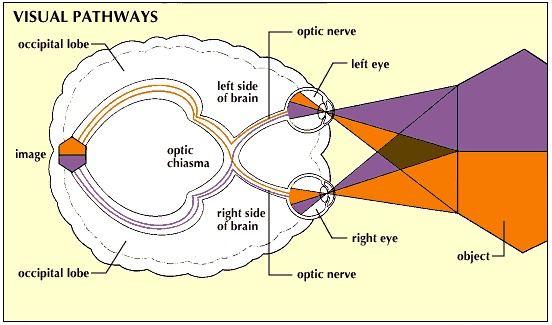optic neuritis
pathology
inflammation of the optic nerve (the second cranial nerve). The inflammation causes a fairly rapid loss of vision in the affected eye (eye, human), a new blind spot (a scotoma, usually in or near the centre of the visual field), pain in the eyeball (often occurring with eye movement), abnormal colour vision, and unusual flashes of light. The condition affects young to middle-aged people and affects women more often than men.
 The optic nerve carries visual data from the retina of the eye to a relay station in the centre of the brain (the lateral geniculate nucleus) for transmission to a cortical area at the back of the brain (occipital lobes). Some instances of optic neuritis occur as a result of multiple sclerosis, a disease of unclear etiology that affects the optic nerve, brain, and spinal cord. Such individuals may or may not have a previous history of neurologic problems, and further testing is often performed to investigate the potential diagnosis of multiple sclerosis. However, other manifestations of multiple sclerosis may not be fully evident until years after the onset of optic neuritis, if they occur at all. Other causes of optic neuritis include infections, such as Lyme disease or syphilis, as well as unknown causes, in which case the optic neuritis is termed idiopathic.
The optic nerve carries visual data from the retina of the eye to a relay station in the centre of the brain (the lateral geniculate nucleus) for transmission to a cortical area at the back of the brain (occipital lobes). Some instances of optic neuritis occur as a result of multiple sclerosis, a disease of unclear etiology that affects the optic nerve, brain, and spinal cord. Such individuals may or may not have a previous history of neurologic problems, and further testing is often performed to investigate the potential diagnosis of multiple sclerosis. However, other manifestations of multiple sclerosis may not be fully evident until years after the onset of optic neuritis, if they occur at all. Other causes of optic neuritis include infections, such as Lyme disease or syphilis, as well as unknown causes, in which case the optic neuritis is termed idiopathic.Optic neuritis may be centred in the optic disk, the point of exit of the nerve from the eye (papillitis), or it may be in the nerve shaft behind the eyeball (retrobulbar neuritis).
The optic nerve usually recovers from the inflammation, and vision gradually improves, but there often is residual degeneration of the nerve fibres and some persistence of visual symptoms. Repeated attacks of optic neuritis occur in some individuals.
- Inc. Murder
- Inc. National Baptist Convention of the United States of America
- Inc. National Baptist Convention, U.S.A.
- Inc. National Broadcasting Co.
- Inc. National Intergroup
- Inc. National Primitive Baptist Convention
- Inc. Northwest Airlines
- income and employment theory
- incomes policy
- income tax
- incongruent melting
- Inc. Pan American World Airways
- Inc. Pentecostal Assemblies of the World
- Inc. Pentecostal Church of God of America
- Inc. Pentecostal Holiness Church
- Inc. PepsiCo
- Inc. PPG Industries
- Inc. Progressive National Baptist Convention
- Inc. REA Express
- Increase Mather
- Incredible Hulk
- incremental repetition
- Increment Rates of Overbank Deposition in Major Floods, Table
- Inc. RJR Nabisco
- Inc. RKO Radio Pictures